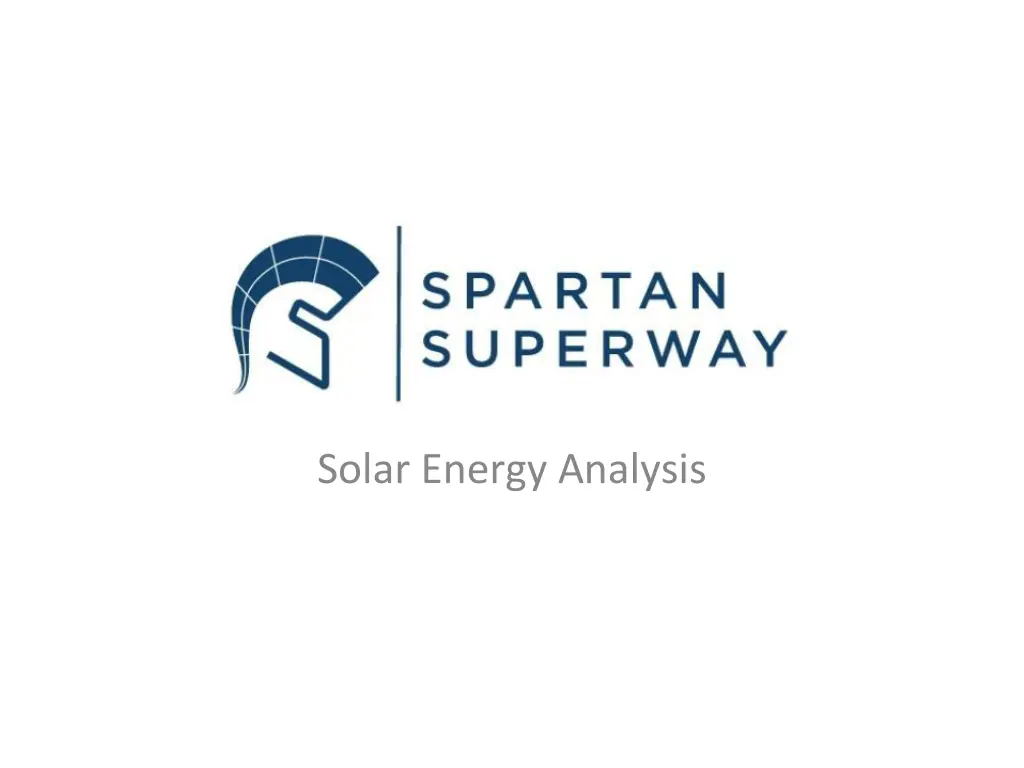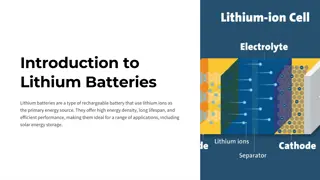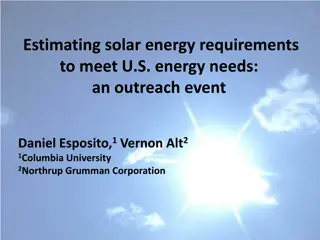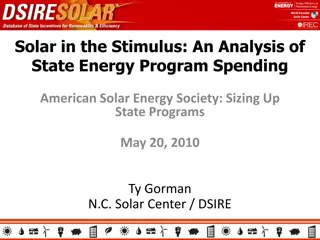
Spartan Superway Solar Analysis for Sustainable Mobility System
"Explore the solar energy analysis conducted by the Spartan Superway team to enhance sustainable mobility in Silicon Valley. Discover their objectives, methodology, and solar panel specifications for optimizing energy efficiency."
Download Presentation

Please find below an Image/Link to download the presentation.
The content on the website is provided AS IS for your information and personal use only. It may not be sold, licensed, or shared on other websites without obtaining consent from the author. If you encounter any issues during the download, it is possible that the publisher has removed the file from their server.
You are allowed to download the files provided on this website for personal or commercial use, subject to the condition that they are used lawfully. All files are the property of their respective owners.
The content on the website is provided AS IS for your information and personal use only. It may not be sold, licensed, or shared on other websites without obtaining consent from the author.
E N D
Presentation Transcript
Introduction Spartan Superway Solar Analysis Team Members: Ali Gharakhani David Torres Uday Ranjeet Justin Dixon Suraj Thapa
Contents 1) Introduction 2) Background 3) Objective 4) Methodology 5) PVWatts Positioning Analysis 6) Vehicle Energy Requirements 7) System Solar Panel Requirements 8) Total Energy Capability 9) Conclusion
Background Sustainable Mobility System for Silicon Valley (SMSSV), otherwise known as Spartan Superway, is an interdisciplinary project from San Jose State University to design a PRT (Personal Rapid Transport) system using renewable resources The objective of the Spartan Superway is to address the following transportation issues: Traffic congestion Loss of productivity from time spent in commuting and/or parking Continued use of and dependence on hydrocarbon fuels Increased possibility of accidents that injure people and damage property Environmental degradation from greenhouse gas emissions and by products from wear out of parts
Solar Analysis Objectives Provide analysis on the power collection capabilities Determine the mounting angle that will provide maximum annual energy output Determine the number of solar panels per length of track required Determine power and energy requirements for a battery system For this analysis the following assumptions were considered: Nominal Speed= 50 Miles/hr Acceleration= 0.5g Vehicle weight including passengers=1900 Kg
Methodology PVWatts was used to determine the optimal tilt angle Force and energy calculations were used to determine the number of solar panels required to operate at constant speed Acceleration energy and max power output was calculated to determine battery requirements A 2 to 1 spacing ratio was used to determine the maximum number of panels that can be positioned along the track
Solar Panel Specs Type: FLEX -02 340 W
PVWatts Positioning Analysis The above chart was composed using the PVWatts tool at PVWatts.NREL.gov. The website uses TMY3 data to calculate direct, diffuse and ground irradiance and outputs the daily output averaged over the period of one year. By inputting an array of azimuth and tilt angles it was possible to determine which azimuth and tilt generates the most energy over the period of one year.
Vehicle Energy Requirements Rolling Resistance The rolling resistance can be expressed as Fr= c W/r where Fr = rolling resistance or rolling friction W = weight of the body cl= rolling resistance coefficient with dimension length r = radius of wheel Constants used Result # of wheels CI [m] Mass w/ passengers[kg] radius [in] 4 Fr [N] 147 3.00E-04 1900 6
Vehicle Energy Requirements Drag Force Drag force can be expressed as: Fd= 1/2 U2A where Fd= drag force = drag coefficient = density of fluid U = flow velocity A = characteristic frontal area of the body Single Cabin Results V [mph] 5 10 20 30 40 50 Fd [N] 2.5 9.9 40 89 159 248
System Solar Panel Requirements # of panels needed per km to operate 5.5 hrs per day 1 3 5 10 17 26 Time to move 1km (s) Energy Produced per Panel (J) Total Energy Required (J) Total Power Required (W) V [mph] 447 224 112 75 56 45 152021 76010 38005 25337 19003 15202 149242 156679 186423 235997 305401 394634 334 701 1668 3167 5464 8826 5 10 20 30 40 50 The number of solar panels required to move the cabin was calculated using the following three step process: 1. Calculate the time required to move the cabin 1 km at the given velocity 2. Calculate the amount of energy produced by a single panel in that amount of time 3. Using the amount of energy required, the time available and the amount of energy produced by a single panel, calculate the number of panels required
Vehicle Energy Requirements Acceleration Force acceleration (m/s2) 4.905 total drag force energy (J) total rolling resistance energy (J) total acceleration energy (J) 6180 7289 462835 total energy during acceleration to 50 mph (J) max power dissipated during acceleration to 50 mph (kW) max power dissipated during acceleration to 50 mph (hp) 476304 212 284 The amount of energy required during an acceleration of 0.5g up to 50 mph was calculated by discretizing time and calculating the energies required to overcome drag force, rolling resistance and inertial forces for each incremental time step. From this calculation we can determine the energy and power output required for a battery that would be used to provide power to the vehicle during acceleration .
Results The above graph shows the amount of energy required to move the vehicle at constant velocity
Results The above graph shows the number of panels required to move the vehicle at constant velocity
Total Energy Capability Using a 2 to 1 spacing to height ratio, the maximum number of panels that can be included in a 1 km length is 1,234 panels. This number of panels can produce 2,308 kWh of DC energy per day on average.
Conclusion The best azimuth for year round energy production considering all azimuths in San Jose is 20 degrees Given the current dimensions, weight and rollers on the vehicle, a total of 8.8 KW are required to move each vehicle at 50 mph. At peak sun output, it would require 26 panels to achieve this power which means that for every 5.5 hours of desired operation per day 26 panels would need to be placed per km, not considering acceleration energy requirements The maximum power output required by a battery to accelerate the vehicle up to 50 mph at 0.5g is 212 kW The total energy output required for acceleration is 476 kJ (or 0.13 kWh) With the current panels selected, and adequate spacing, the maximum energy output capability is 2308 kWh/day
References 1. https://www.freehotwater.com/solar-calculators/ 2. http://miasole.com/uploads/media/FLEX-02W_Datasheet_1.pdf 3. www.engineeringtoolbox.com 4. http://pvwatts.nrel.gov/






















